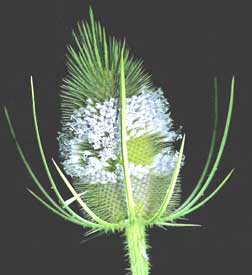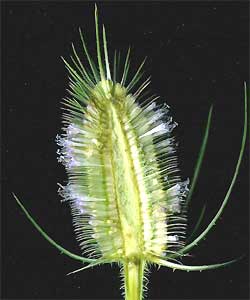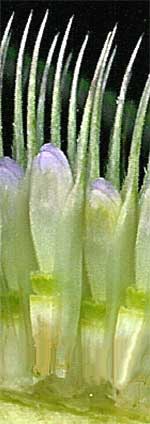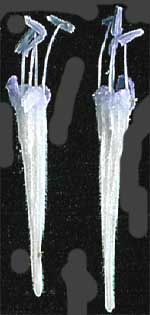Excerpts from Jim Conrad's
Naturalist Newsletter
from the July 13, 2006 Newsletter issued from Issued from Polly's Bend, Garrard County, in Kentucky's Bluegrass Region, USA
TEASELS FLOWERING
When I arrived here in late April the landscape had just turned vibrantly green, but here and there vestiges of winter hung on. One wintry thing was a nice population of 7-ft-tall, brown, dead Teasel skeletons from last year, on an old-field slope above the spring. How out of place those stiff, gaunt, spiny things looked all surrounded by lush spring greenness!

Our Teasel species is DIPSACUS SYLVESTRIS, an invasive from Europe. Teasel flowers show a lot of affinity for the blossoms of composites such as daisies and chrysanthemums, but they are in their own family, the Teasel Family, the Dipsacaceae.
I've been looking forward to Teasel-flowering time, and that time has come. It's not that Teasels are such gorgeous plants -- most people confuse them with thistles -- but rather they are unusual. You can see what I mean by looking at the flowering head at the right, an image greated with Ruth's scanner.

A longitudinal section of the flowering head showing how the individual flowers are packed next to one another on the head's central column is at the left.

A close-up showing unopened flowers next to the spiny bract-tips accompanying each flower is shown at the right.
Individual open flowers showing stamens arising fromthe corollas is at the left.

When young Teasel plants began emerging in May they were pretty eye-catching. They consisted of a stiff, straight stem on which two large leaves arose at each connecting point, or node, and the leaf bases merged with one another so that a cuplike depression surounded the stem where the leaves arose. In fact, the leaf bases formed such a fine cup that when it rained a substantial quantity of water pooled there, staying for days at a time! Goldfinches and other small birds had plenty of water sources those days.
I don't see Teasels elsewhere at Polly's Bend so I'm guessing that someone here long ago cultivated them, and the ones beside the spring are escapees from those days. There's good reason why pioneers might have cultivated them. Once the flowers have set fruit and the flowering heads have dried out, the heads are so spiny and stiff that in the old days they were used as combs. The dried head of another Teasel species was even used in the textile industry to raise the nap on fabrics -- to tease the fibers to stand up.
In fact, "teasing fiber" accounts for the Teasel's name. Then you wonder where "tease" came from. Well, it's from the Old English "tæsan," meaning "pluck, or pull apart." Interestingly, according to the Etymology Online Dictionary (http://www.etymonline.com), the hairdresser's phrase "teasing hair" only arose around 1957. Can it be that when I was nine years old in 1956 if I'd asked my mother to tease my hair she wouldn't have understood?